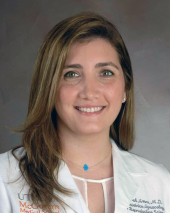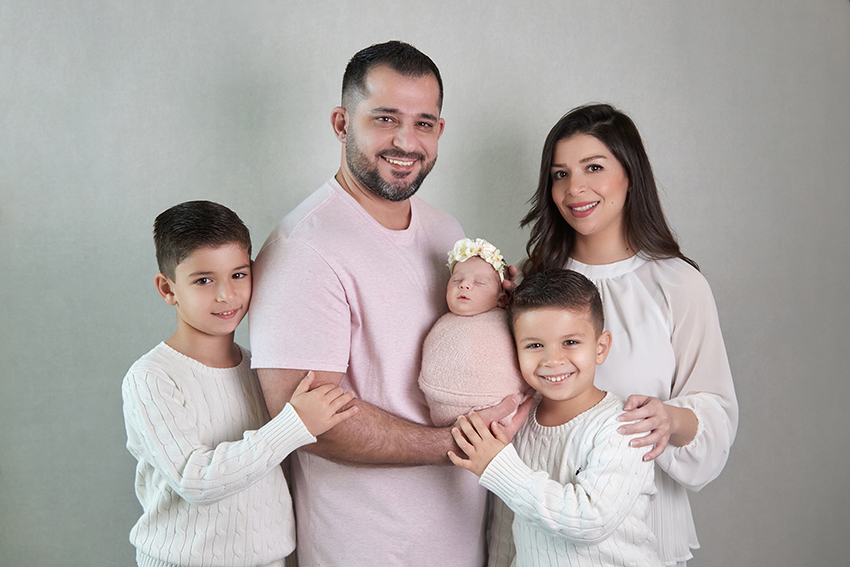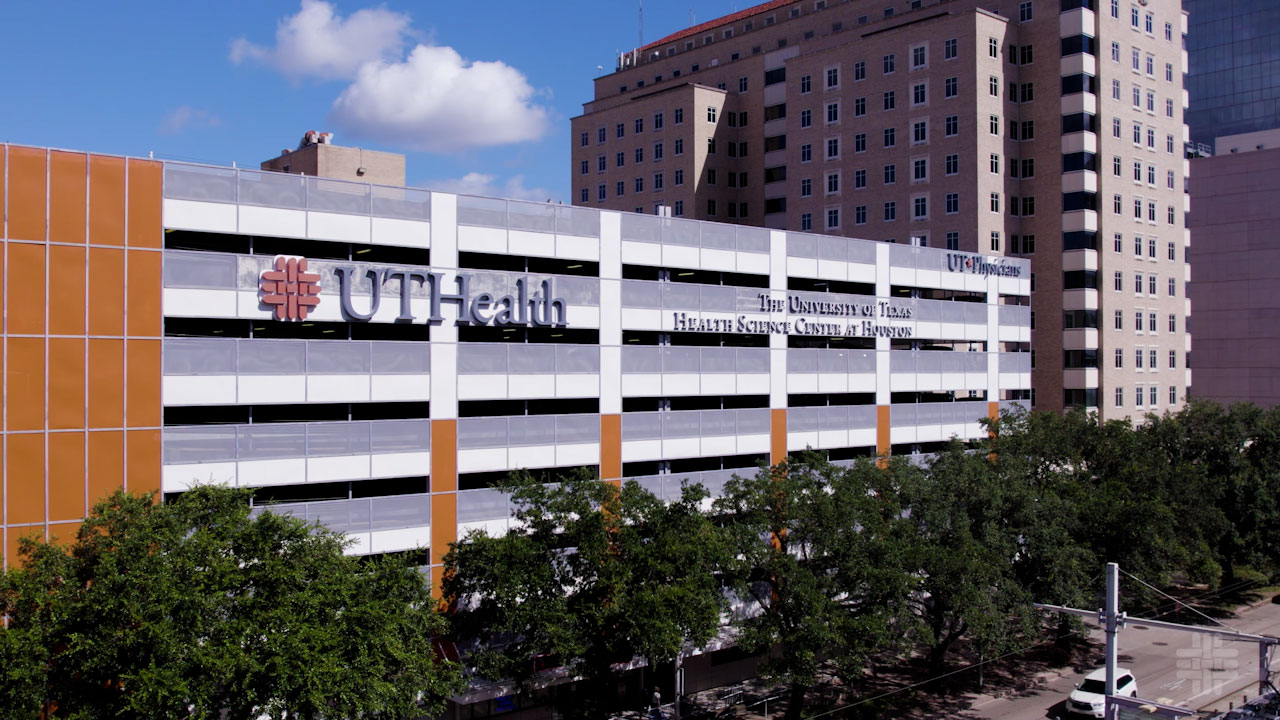Gushing over her baby girl, Mona Bleibel recounts the nearly two years she spent hoping for a daughter. “I almost gave up,” she said.
The mother of two boys, 5 and 7, said her dream came true when she learned she was finally pregnant and would be having a girl.
But the pregnancy that answered her prayers also presented life-threatening complications for Mona.
Placenta accreta diagnosis

It was during her 20-week anatomy ultrasound when Mona’s OB-GYN discovered she had placenta accreta.
She was referred to Diana A. Racusin, MD, a maternal-fetal medicine specialist with UT Physicians.
“Placenta accreta happens when the placenta grows into the uterine wall while developing,” explained Racusin. “This is a problem because the placenta can’t be delivered naturally at the time of birth.”
Causes of placenta accreta
Placenta accreta is caused by abnormal implantation of the placenta, typically at a site where there’s a scar from a previous uterine surgery, such as a cesarean section.
“The more uterine surgery you’ve had, the higher the risk for developing placenta accreta in pregnancy,” said Racusin, an assistant professor with McGovern Medical School at UTHealth Houston.
Mona had a history of complicated pregnancies and each of her first two babies was born via C-section.
Risks of placenta accreta
The biggest risk with this pregnancy complication is life-threatening bleeding.
“In a normal case, after the baby and placenta are delivered, the uterus will shrink back down to size,” explained Racusin. “If the placenta isn’t taken out correctly, or there is anything left inside that can interfere with the uterus shrinking down, you can lose a lot of blood.”
Medical options for placenta accreta
Traditionally, placenta accreta treatment in the U.S. is a hysterectomy following the baby’s birth.
“That’s the protocol because if we don’t take out the uterus with the placenta, you could hemorrhage and risk death,” said Racusin. “That has been the standard of care for a long time, and that’s what most people do.”
However, removing the uterus eliminates the option for future pregnancy, leaving patients with a devastating diagnosis.
In 2015, UT Physicians started the Placenta Accreta Program to offer another treatment option called conservative management.
“This is unique and different than many places across the country,” said Racusin.
Through this program, the patient is allowed to go home after the baby is delivered with the placenta still inside the uterus. The goal is for the placenta to slowly detach itself, thus saving the uterus from hysterectomy and preserving potential future fertility.
Conservative management of placenta accreta – uterine preservation
Choosing this treatment method comes with very strict protocols and rigorous follow-up.
Patients must stay in the hospital for several days after their C-section for monitoring and antibiotics.
Then, they return for frequent follow-up appointments until the placenta is absorbed or passed.

The entire process can take up to six months, and every appointment includes an ultrasound.
“We counsel our patients extensively and have a multidisciplinary approach to create a plan for each individual,” said Farah H. Amro, MD, medical coordinator for the Placenta Accreta Program.
Choosing the conservative management option doesn’t automatically mean the uterus will be preserved.
Since the program’s inception, 28 patients have chosen this option. Of those, 13 were able to safely deliver the placenta and avoid hysterectomy.
The risks of conservative management include infection and bleeding, both of which have been seen in 10%-15% of patients. These complications can lead to emergency hysterectomies.
“There are also some situations where the placenta may separate during the C-section, and in that case, a hysterectomy would need to be performed,” said Amro, an assistant professor in the Department of Obstetrics, Gynecology and Reproductive Sciences with McGovern Medical School at UTHealth Houston. “We make sure to help guide our patients through every step of this long stressful process.”
It may not be right for every patient, but Mona said it was the right path for her, and she chose this option.
Healthy newborn delivery
In January, Mona was admitted to the hospital for a planned C-section at 35 weeks pregnant. A healthy baby girl was delivered without complications.
Racusin left the placenta intact, and Mona began an eight-day hospital stay where she was monitored for potential bleeding and given antibiotics.
She was discharged from the hospital and began strict follow-up instructions, meeting weekly with the placenta accreta care team at the Texas Medical Center.
Delivering the placenta

One month later, Mona began bleeding at home and was rushed to the hospital.
“We could see the placenta was starting to peel away from the uterus, which was causing blood loss and pain,” said Sean C. Blackwell, MD, a maternal-fetal medicine specialist with UT Physicians. “We stabilized her, gave her blood transfusions, and took her to the operating room to remove the placenta.”
Out of an abundance of caution, Mona was prepared for surgery. She was intubated and underwent general anesthesia.
Blackwell manually delivered the placenta vaginally without having to open her abdomen and remove her uterus.
“Despite having a seriously adherent placenta accreta, she was able to keep her uterus without significant complications, even though it was hard on her and she had to be in the intensive care unit and have multiple blood transfusions,” said Blackwell, chair of the Department of Obstetrics, Gynecology and Reproductive Sciences and the Berel Held, M.D., Professor in ObGyn and Reproductive Sciences with McGovern Medical School at UTHealth Houston. “It was very important to her to try to preserve her uterus, and we were blessed to be able to honor her wishes safely.”
Following the placenta removal, Mona spent an additional five days in the hospital, including in the intensive care unit for monitoring.
Saving her uterus
“We do something really uncommon in the United States,” said Blackwell. “To be able to safely preserve a woman’s uterus despite having placenta accreta requires specialized coordination and care. It is not without risks. We are very clear about the challenges and requirements. But our program provides an option for women to avoid hysterectomy in the setting of placenta accreta.”
The choice to save her uterus did not come easy and was not made lightly, but Mona said she followed her instincts.
“It took me months to decide if I should choose this route,” she explained. “I had a lot of mixed feelings, doubt, and second-guessing, but I’m happy I did this. I wanted to keep my uterus.”
Mona felt empowered by her medical team at UT Physicians to have a say in her health care and, because of that, felt confident in her final decision.
“The doctors are there for you,” she said.
“I think patient autonomy is really important in medicine, especially in these complex cases,” said Racusin. “I’m proud that she was able to make the decision in line with her wishes and advocate for herself, which can be difficult.”




